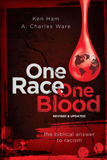All in the Family
Just because a family member looks a little different doesn’t make her a different race—even if she’s adopted.
When I write or talk on the issue of race, it’s always a deeply personal experience for me. My husband, Chris, and I decided to adopt a child from China 13 years ago. We knew this was God’s will for us, but I was haunted by this question: Could I raise a child of another race? I never would have called myself a racist in those days, but in reality I was. My opinions and beliefs about those who looked different from me did not reflect the biblical truth that we are all one race.
It All Begins in Genesis
In Genesis 1:26–27 we read that God created two people, man and woman (later called Adam and Eve). God distinguished them from the animals by creating them in His image and giving them dominion over all that He had made. Adam named his wife Eve “because she was the mother of all living” (Genesis 3:20). This name makes sense only if everyone on earth would come from this one couple. So the term races is not appropriate to distinguish humans from each other because we are all one race descended from Adam and Eve.
Can You Marry Your Relation?
Of course one question that naturally follows is, whom did Adam and Eve’s children marry—where did their first son, Cain, get his wife? Well, if God created only two people from whom the entire human race would come, then Cain had to marry either a sister or a niece. Up until 2500 years after creation, it was not uncommon or sinful for close relatives to marry. It was not until the time of Moses, in Leviticus 18:6, that God prohibited marriage of close relatives. Today such marriages can produce children with genetic defects, since both parents are more likely to be carriers of the same defective genes. But the accumulation of defective genes is a gradual process and would not have been problematic for our earliest ancestors.
If We’re All Related, Why Do We Look So Different?
Most children’s books portray Adam and Eve as fair-skinned and blond. But a fair-skinned couple would not possess the genetic variety needed to achieve all the different skin tones we see today. Adam and Eve probably had a middle-brown skin tone from a mixture of “light color” genes and “dark color” genes. Their descendants could then exhibit a wide range of skin tone from very light to very dark with most somewhere in between (as seen in the world today). Adam and Eve likely possessed genetic variation for eye shape and other common distinguishing characteristics as well.
We should stop using the term race to describe different people groups. It is unhelpful and inaccurate.
The reason certain groups of people display distinct physical traits stems from an event about 1700 or so years after creation. In Genesis 11, God judged the people at the Tower of Babel by confusing their language, and they migrated to many different parts of the world. Groups of people became isolated from others and likely married only within their language group. Each group carried a set of physical characteristics determined by their genes. Certain characteristics dominated as they intermarried because of the group’s small pool of genes. Over time, different people groups displayed distinct physical characteristics. For example, Asians, like my daughter Elizabeth, have almond-shaped eyes, dark hair, and middle-brown skin, whereas those of European descent, like me, have round eyes and fair-colored hair and skin. I use the term people group because it describes these differences without the unbiblical implications of the word race. For example, my daughter belongs to the Chinese people group.
Genetics also confirms the biblical truth of one race. The difference in DNA between any two humans is only 0.1%. The DNA for traits that distinguish people groups makes up only a very small fraction of that 0.1%. From a biblical and scientific perspective, we should stop using the term race to describe different people groups. It is unhelpful and inaccurate.
Why One Race Matters for the Gospel
The Bible makes a clear connection
between the first Adam (in Genesis)
and the last Adam, Jesus Christ. “For
since by man came death, by Man also
came the resurrection of the dead. For
as in Adam all die, even so in Christ
all shall be made alive
”
(1 Corinthians 15:21–22, see also verse 45). Adam
sinned, and because we all descend
from him, we all sin. Jesus Christ died
to save sinners.
The problem of sin—the bad news—begins in Genesis at the Fall; and the solution to sin—the good news—is found in the death and resurrection of Jesus. Christ died only for Adam’s race. If there are other races, descended from people other than Adam, then they are dead in their sins (Romans 3:23), yet unable to receive salvation. The Bible says we are all one race (Acts 17:26) and that God’s gift of salvation is available to all who believe (Romans 10:9).
Our Adoption Journey
As I searched the Bible and prayed about raising a child of a different race, I discovered that my concern was irrelevant. Our daughter was of the human race just like Chris and me and was even biologically related to us (albeit distantly)! Knowing this biblical truth, which is confirmed by science, lifted a huge weight off my shoulders. I eagerly anticipated the day when I would hold my daughter in my arms.
I remember attending a family reunion a few months after we returned from China. As I played with Elizabeth, a young girl asked me if I was really her mother. At first I just looked at the girl in disbelief—why would she question something so obvious? But then I realized it was because Elizabeth and I look different. I recognized then that my thinking on race had changed. I no longer noticed those differences; all I saw was my daughter whom I loved very much.
Related Videos
Why Do We Look Different?
Answers Magazine
January–February 2017
Secular scientists claim it’s easy to disprove the Bible’s 6,000-year history: just count the tree rings. But this dating method is not as reliable as you might think.
Browse Issue SubscribeRecommended Resources

Answers in Genesis is an apologetics ministry, dedicated to helping Christians defend their faith and proclaim the good news of Jesus Christ.
- Customer Service 800.778.3390
- © 2024 Answers in Genesis






